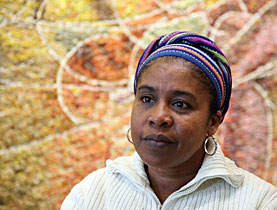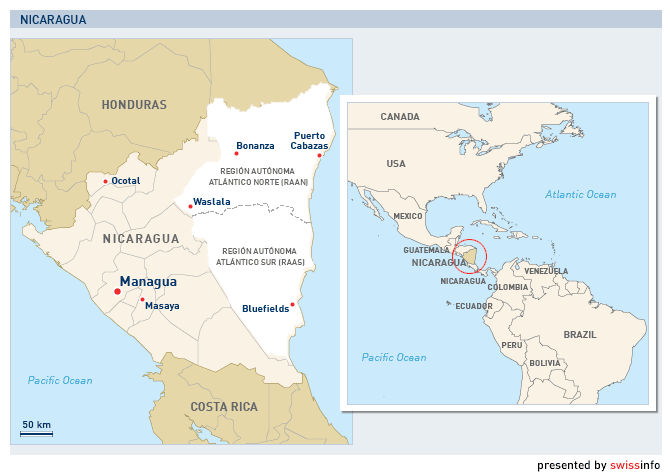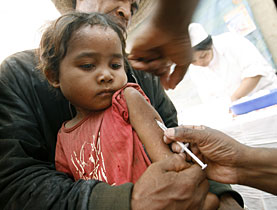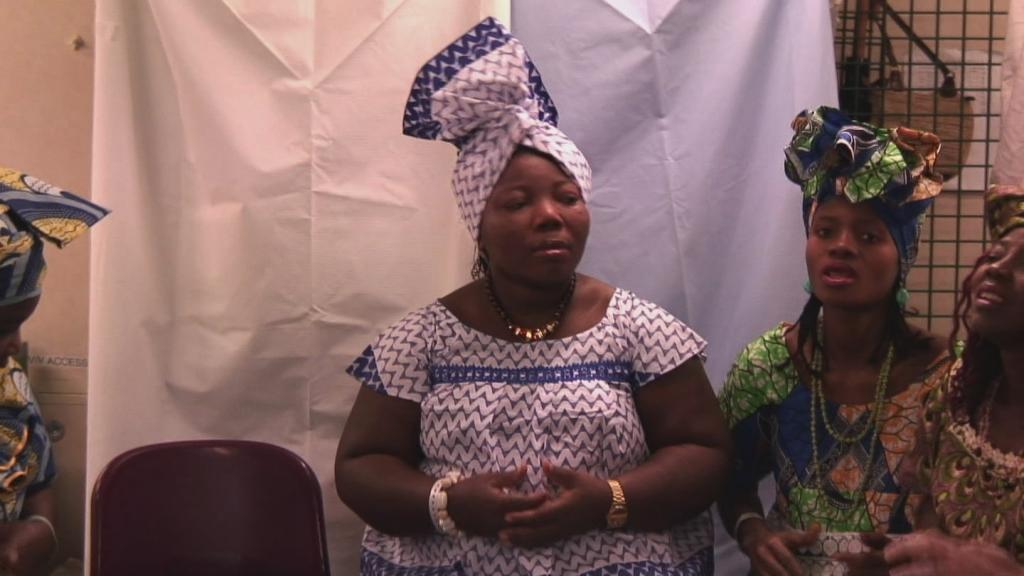Poor Nicaragua and rich Switzerland swap ideas

The Swiss with their four languages and cultures may wonder what holds them together. But Swiss problems pale into insignificance compared with those of Nicaragua.
The eastern half of Nicaragua which faces the Atlantic – and which includes the area familiar to film buffs as the Mosquito Coast – is a patchwork of different peoples. Six different languages are spoken there, and the mix of languages reflects a mix of culture too.
The area is a world away from the monocultural, Spanish-speaking west, where the bulk of Nicaraguans live. Even travelling between the two is a challenge, since there is no road link.
Hazel Wilson, a teacher from the Atlantic coast, visited Switzerland recently to see how the Swiss deal with their mixture of languages and cultures and to exchange information about their respective experiences.
Wilson coordinates the intercultural bilingual educational programmes of a local non-governmental organisation, Fadcanic – the Foundation for the Autonomy and Development of the Atlantic Coast of Nicaragua – which is active in education, agriculture and the environment.
She was invited by a Swiss NGO, the GVOM (Group of Overseas Volunteers), which works mainly in Latin America, with Fadcanic amongst others.
Contrast
Despite the superficial similarities between the two countries, Wilson was more struck by the contrasts. She told swissinfo what she had seen at a high school in Geneva offering bilingual teaching.
“The bilingual education there is for students with the highest grades. You have to compete to be part of a bilingual programme. It’s for a privileged group of society,” she said.
“In the Atlantic coast, bilingualism is a priority at primary level, and it is free of charge. It’s an opportunity granted to all who have a mother tongue other than Spanish.”
But the aims and methods of teachers working with immigrant children in Geneva were more familiar. Here the focus was not only on language acquisition, but also on helping the children with their cultural awareness.
“The language the children use at home is important, and the teacher tried to develop the opportunity, if only for 30 minutes a week, for the children to express something in their own language. It’s a way of motivating them, lifting their self-esteem and valuing their identity. This is very positive to build intercultural relations,” she said.
Intercultural education
The work that Wilson is doing at home runs along similar lines, where the stress is on intercultural education as much as on bilingualism.
“Culture is taken into account during the learning process, with the idea that we learn from each other’s cultures. Helping us to understand each other is vital for us to work together in the same territory and build a better way of life for the new generation. It’s a way to diminish inter-ethnic conflict and strengthen leadership in multi-cultural settings,” she explained.
As a rich country, Switzerland has countless advantages over Nicaragua. Perhaps surprisingly, however, it was not so much the facilities nor the small class sizes, that Wilson envied most.
“I see that the teachers working in these classes have a lot of training. I believe the quality education that you have here is a result of quality training, more than the material conditions that you have.”
At the same time, she was struck by a conversation with one of the educationalists whom she met, who warned that however useful it is to exchange experience, not everything can be carried over from one situation to the other.
“Every classroom is a different setting, and every classroom needs a different treatment, and we learn different things from each other. So there is not one formula that can be used to develop the quality education we dream about,” she said.
Money
Schools on the Atlantic coast are greatly disadvantaged in comparison with Switzerland in another way too. Wilson explained that the government does not have enough money to guarantee education for all, and it prioritises the monolingual schools on the Pacific side of the country.
It is up to civil society to try to bridge the gap, and come up with projects for intercultural bilingual education. Fadcanic looks for donors to support these initiatives. About half of the funds for Wilson’s work comes from the government, and the other half from elsewhere.
But Wilson wasn’t looking for financial support during her visit. Switzerland contributes something else: well-trained volunteers. “We believe Swiss people have a lot to share,” she said.
“We are convinced that education is the only solution which we have to come out of the extreme poverty we are facing today.”
But in keeping with the philosophy behind her work, she pointed out that despite the fact that the Swiss bring skills that the Nicaraguans do not have, the benefit is not all one way.
“Even though we live in a very poor situation economically, we are rich culturally, and the people who have gone, as long as they are open to learn, they will learn from the things that we do.”
swissinfo, Julia Slater
The Atlantic, or Caribbean, coast of Nicaragua was colonised by Britain, unlike the western part of the country, which was colonised by Spain.
The Spaniards imposed Roman Catholicism and the Spanish language and indigenous cultures disappeared.
Under British rule the indigenous peoples survived. They were converted to Protestantism by German missionaries in the 19th century.
The Atlantic coast was incorporated into Nicaragua in 1894.
Foreign companies were allowed to exploit the region’s natural resources, but the population remained in poverty.
The area now consists of two autonomous regions – Región Autónoma del Atlántico Norte-RAAN, y la Región Autónoma del Atlántico Sur-RAAS – established in 1987.
Its surface area accounts for 45.8% of the total area of Nicaragua – equivalent to nearly one and a half times the size of Switzerland.
The population of the Atlantic Coast consists of six different ethnic groups.
Three are descendents of indigenous peoples of the areas, two are descended from different slave groups, and the other are the Mestizo, who migrated from the Pacific coast.
Altogether they account for about 11% of the total population of the country.
One third of the population lives in the urban areas.
43% of the population over the age of ten is illiterate; the rate is even higher among women and people living in rural areas.
The programme coordinated by Wilson offers bilingual inter-cultural education in three combinations:
Spanish-English, for the African descendants
Miskito-Spanish and Mayangna-Spanish for two of the indigenous groups.
Fadcanic gets most of its budget from Austrian organisations.
Swiss volunteers have been working with Fadcanic since 2000.


In compliance with the JTI standards
More: SWI swissinfo.ch certified by the Journalism Trust Initiative



You can find an overview of ongoing debates with our journalists here . Please join us!
If you want to start a conversation about a topic raised in this article or want to report factual errors, email us at english@swissinfo.ch.